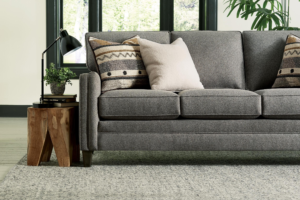Choosing the right upholstery fabric for your furniture is crucial for both aesthetics and functionality. With a myriad of options available, it can be overwhelming to make the right choice. The ideal fabric should enhance your decor, withstand daily wear and tear, and provide comfort. This guide will walk you through thChoosing the right upholstery fabric for furniture is a vital decision that impacts the durability, comfort, and overall aesthetics of your pieces. A well-chosen fabric can extend the lifespan of your furniture while complementing the design and functionality of your space. With so many fabric types, styles, and features available, it can be challenging to decide which is best for your needs. This guide dives deep into the factors you need to consider and provides insights to help you make the perfect choice.
1. Assess Your Lifestyle and Usage Needs
The way you use your furniture and the environment it’s in are primary considerations when selecting upholstery fabric. Your lifestyle heavily influences the material’s suitability.
High-Traffic Areas
For furniture in high-use areas like family rooms, durability is critical. Sofas or chairs in these spaces need fabrics that can withstand frequent wear and tear. Materials like microfiber, polyester blends, and performance fabrics such as Crypton or Sunbrella are designed for heavy use. These materials are stain-resistant, durable, and easy to clean, making them ideal for homes with frequent gatherings or guests.
Homes with Children
Children often bring excitement and energy—but also spills, stains, and rough handling of furniture. Upholstery fabrics in family-friendly homes should be robust, stain-resistant, and low-maintenance. Performance fabrics, especially those with moisture and stain repellents, provide an excellent solution. Additionally, microfiber is highly resistant to spills and marks, making it a top choice.
Pet-Friendly Spaces
Pet hair, scratches, and accidental stains are common challenges for pet owners. Consider tightly woven fabrics like microfiber that prevent claws from snagging. Leather is also an excellent choice because it doesn’t trap pet hair and is easy to wipe clean. Avoid loosely woven materials like linen or chenille, which can be easily damaged by claws or fur buildup.
Formal or Low-Traffic Areas
For furniture in formal settings or decorative pieces that aren’t used daily, aesthetics can take precedence over durability. Luxurious materials like silk, velvet, or linen add sophistication and elegance to these spaces. While these fabrics are more delicate, they elevate the room’s overall ambiance.
Key Takeaway: Choose a fabric that matches the level of activity and the people or pets using the space. Balance durability with aesthetics based on how often and by whom the furniture will be used.
2. Prioritize Durability
Durability is one of the most critical factors when selecting upholstery fabric, particularly for furniture that sees frequent use. The durability of a fabric is determined by factors such as its weave, material type, and double rub count.
Understanding Double Rub Count
The double rub test measures how many times a fabric can be rubbed before showing signs of wear. This number gives a clear indication of the fabric’s resilience:
- Light Use (10,000–15,000 Double Rubs): Suitable for decorative furniture or pieces in guest rooms that experience infrequent use.
- Medium Use (15,000–25,000 Double Rubs): Ideal for furniture in home offices or living rooms with moderate traffic.
- Heavy Use (25,000+ Double Rubs): Designed for sofas and chairs in busy households or commercial settings.
Choosing Durable Fabrics
- Leather: Known for its long-lasting nature, leather is a popular choice for high-traffic furniture. It resists wear and tear while maintaining its appearance over time.
- Microfiber: This tightly woven synthetic fabric is highly durable, resisting pilling, staining, and abrasion.
- Performance Fabrics: Fabrics like Sunbrella and Crypton are engineered for resilience. They resist moisture, stains, and UV damage, making them perfect for both indoor and outdoor use.
Key Takeaway: For furniture that will be heavily used, select a fabric with a high double rub count and proven durability features.
3. Focus on Maintenance and Cleaning
How easy the fabric is to clean and maintain is another vital consideration, especially in households with children or pets.
Low-Maintenance Fabrics
Materials like microfiber, vinyl, and polyester blends are excellent choices for furniture that needs regular cleaning. These fabrics resist stains and spills, allowing for quick clean-up with a damp cloth or mild detergent.
High-Maintenance Fabrics
Luxurious fabrics like velvet, silk, and linen require more care. These materials may be prone to staining and wrinkling, often needing professional cleaning to maintain their appearance. While they provide a high-end look, they may not be practical for everyday use.
Removable Covers
For extra convenience, consider furniture with removable slipcovers. These are machine washable, making them an excellent option for family homes or rental properties.
Key Takeaway: Match the fabric’s maintenance requirements with your cleaning preferences and time availability. Opt for performance fabrics if low-maintenance care is a priority.
4. Consider Comfort and Feel
A sofa or chair should not only look good but also feel comfortable. The fabric’s texture, softness, and temperature regulation all influence how enjoyable the furniture is to use.
Soft Fabrics for Relaxation
Materials like velvet, chenille, and microfiber are ideal for cozy furniture. Their plush surfaces create an inviting space for lounging or curling up with a book.
Breathable Fabrics
Natural fibers like cotton, linen, and wool are breathable, making them comfortable for prolonged sitting. They’re especially suited for warm climates, as they help regulate temperature.
Smooth and Sleek Fabrics
For a modern look, smooth materials like leather or faux leather offer sleekness and elegance. While they may not have the softness of velvet or chenille, they are easy to clean and maintain.
Key Takeaway: Comfort is subjective—test fabric swatches to determine the texture and softness that best meet your needs.
5. Match the Fabric to Your Style
The fabric you choose should complement the design of your furniture and the overall style of your space.
Color Choices
- Neutral Tones: Colors like beige, gray, and cream are versatile and timeless, blending seamlessly with various decor styles.
- Bold Colors: For a more dramatic look, opt for statement colors like emerald green or deep navy.
- Dark Colors: These are practical for hiding stains and are ideal for family homes or high-traffic furniture.
Patterns
- Solids: Simple and versatile, solid fabrics are easier to coordinate with other elements in the room.
- Patterns: Stripes, florals, or geometrics add visual interest but can be harder to match with changing decor.
Textures
- Smooth Fabrics: Leather and polyester offer a clean, modern look.
- Textured Fabrics: Tweed, bouclé, and chenille add depth and warmth, making them great for traditional or cozy spaces.
Key Takeaway: Consider the color, pattern, and texture of the fabric to ensure it aligns with the room’s aesthetic and your personal style.
6. Factor in Environmental Conditions
Environmental factors, such as sunlight exposure and humidity, can impact the durability and appearance of upholstery fabric.
Sunlight Exposure
If the furniture will be placed near windows or in sunlit areas, choose fade-resistant fabrics like Sunbrella or polyester blends. Avoid materials like silk or cotton, which may fade or weaken over time.
Humidity and Moisture
In humid or damp environments, moisture-resistant fabrics like olefin or performance-treated materials are essential to prevent mold and mildew growth.
Key Takeaway: Protect your furniture from environmental damage by selecting fabrics designed to withstand sunlight and humidity.
7. Budget Considerations
The cost of upholstery fabric varies widely, so it’s essential to balance your budget with your priorities.
High-End Fabrics
Luxurious options like leather, velvet, and designer linens come at a premium but provide timeless elegance and long-lasting quality.
Affordable Options
Fabrics like microfiber, vinyl, and basic polyester blends are budget-friendly without compromising on durability.
Key Takeaway: While high-quality fabrics may have a higher upfront cost, they often save money in the long run by reducing the need for replacements or repairs.
Conclusion
Choosing the best upholstery fabric for furniture requires thoughtful consideration of your lifestyle, maintenance preferences, and design goals. By evaluating factors like durability, comfort, and environmental suitability, you can find a fabric that not only looks beautiful but also meets the demands of everyday life. Whether you prioritize luxury with velvet, practicality with performance fabrics, or durability with leather, the right choice will ensure your furniture remains stylish and functional for years to come.











